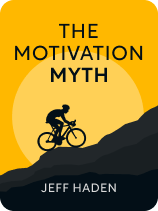

This article is an excerpt from the Shortform book guide to "The Motivation Myth" by Jeff Haden. Shortform has the world's best summaries and analyses of books you should be reading.
Like this article? Sign up for a free trial here.
What is the best daily routine for success? How can a routine keep you motivated?
In The Motivation Myth, Jeff Haden urges you to create a program that will lead you straight to success. A crucial part of this program is a daily routine that makes it easier for you to make choices and manage your time.
Continue reading to learn how to create an everyday routine to help you reach your goals.
Build Your Routine
A good success program will let you laser-focus on your next step and nothing else. Here, we’ll discuss how to choose a program to follow and how establishing the best daily routine for success eliminates the need for willpower.
Thankfully, when plotting your course, you don’t have to reinvent the wheel or rediscover fire. Chances are that whatever you aspire to, whether it’s to paint professional-level murals or to kayak down Class V rapids, someone else has already achieved it and mapped out a program to get there. You merely have to do your research and choose from the many different programs available. Haden suggests that you shouldn’t waste time fretting over which program is the most ideal for you because you have no way of knowing until you’ve started. The advantage of any good program toward success is that it lays out every step you need to take, saving you the time and effort of figuring it out for yourself.
(Shortform note: This may be the easiest step in Haden’s program by far. Over the last few decades, an entire industry has sprung up around providing step-by-step instructions to people with minimal knowledge of any subject. The popular For Dummies and Idiot’s Guides series began in the early 1990s and now boast editions on thousands of subjects. Free online courses can be found on a variety of topics, including business, technology, and language learning. Further learning resources can be found through continuing education courses at colleges and universities, as well as by visiting your local public library.)
The next vital component is to turn your program into a routine. By making your efforts toward your goal automatic, a routine negates the need for motivation. Without a routine, every day and moment means you must consciously choose whether to follow your program or do something else, such as binge-watch TV or play games on your phone. Having to make that choice depletes your will and makes it more likely that you won’t follow through. However, if you establish a routine that keeps you on your program, you’ll no longer have to decide what to do. Followed long enough, a routine makes the steps toward your goal a part of your identity—it’s not just what you do, it’s who you are.
(Shortform note: Haden’s words on the power of routine echo those of Greg McKeown, author of Essentialism. However, McKeown warns that a poorly designed routine can lead to boredom and stifle the creative energy you’re trying to free up. Setting up a beneficial routine involves changing your daily habits so that the cues that trigger unproductive behavior—such as snacking or surfing the internet—instead become associated with productive activities, such as brainstorming ideas for the next step to your goal.)
Establishing a routine is easier said than done. Haden offers several tips to make it less of an uphill battle:
- Redesign your workspace to eliminate distractions (such as putting away your phone and closing your door so you won’t be interrupted).
- Place reminders of your overall goal, such as sticky notes and photos, in places where they’ll interrupt temptations (such as on your refrigerator or in front of your TV).
- Keep healthy snacks easily available (such as fruits, vegetables, or nuts) to keep your energy levels from flagging.
- At the end of each day, plan out the next one, so you won’t have to spend that energy in the morning. Use that start-of-day energy instead to tackle your hardest task first.
| Different Approaches As with any list of productivity tips and suggestions, the literature is full of elaborations and counter-examples. For instance, in The 10X Rule, Grant Cardone says that instead of leaving yourself reminders of your goals, you should write them down at least twice a day as part of your routine. In Make Time, Jake Knapp and John Zeratsky argue that to avoid distractions, it isn’t enough just to put away your phone—you should delete all social media apps, games, and even your email from it. Knapp and Zeratsky also give more detail on how to strategically use food to fuel your program, pointing out that unprocessed snacks give a longer energy boost than treats full of sugar and caffeine. Whereas Haden emphasizes starting each day with the hardest task before you, many other productivity experts make the distinction that you should start with the most important task. In First Things First, Stephen R. Covey presents a method to evaluate your to-do list based on whether tasks are urgent or important, stressing that you should begin with action items that are both while completely ignoring any tasks that are neither. In Eat That Frog!, Brian Tracy prioritizes tasks based on the rule that 20% of your actions produce 80% of your results, and he states that focusing on small, easy action items to “get them out of the way” is a never-ending battle and a waste of your time. |

———End of Preview———
Like what you just read? Read the rest of the world's best book summary and analysis of Jeff Haden's "The Motivation Myth" at Shortform.
Here's what you'll find in our full The Motivation Myth summary:
- Why you should stop waiting for motivation to hit and instead, make your own
- How to create a cycle of positive reinforcement to boost your motivation
- How to develop resilience to get through times of struggle






